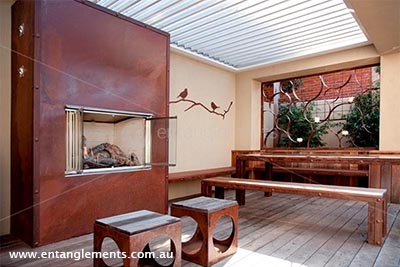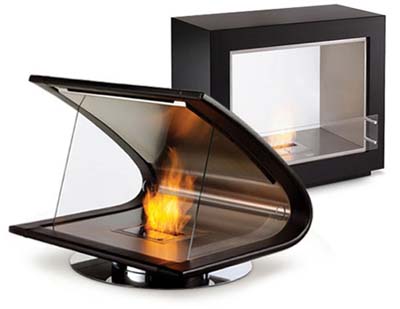As the colder weather creeps in, home heating starts becoming a real issue for many reasons. Not only do you need to keep warm but heating can be expensive if you don't choose the right type.
A fireplace not only warms but can become a focal point in your home just like a camp fire does outside.
Fireplaces are now increasingly being designed into outdoor living areas. They're a stylish way to make outdoor entertaining cosy and inviting, allow outdoor spaces to be enjoyed all year.
Fireplaces have a reputation of being environmentally unfriendly because of their inefficiencies and emissions, which can also have adverse health effects. However, good design, as well as choice and handling of fuel, can improve both the efficiency of the fire and the release of emissions.
Issues to consider when adding a fireplace in your home
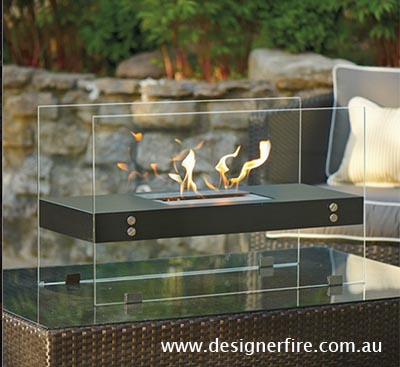 Emissions - Burning wood compared to burning ethanol or gas requires different appliances due to the emissions they produce. These emissions can cause health and other problems, not only for you, but also your neighbours. Emissions need to be considered and planned for. Wood causes the most potent emissions, gas less than wood, and ethanol the least.
Emissions - Burning wood compared to burning ethanol or gas requires different appliances due to the emissions they produce. These emissions can cause health and other problems, not only for you, but also your neighbours. Emissions need to be considered and planned for. Wood causes the most potent emissions, gas less than wood, and ethanol the least.
Ventilation - When you're using wood, gas or coal as a fuel source, the emissions need to be vented via a chimney or flue. Ethanol is a very clean burning fuel and does not require flue or chimney. However you do need to be aware of the ventilation issues with ethanol fuelled fire places.
Contrary to popular believe ethanol fires can produce a substantial amount of heat and can also be portable.
Building codes govern the building of fireplaces and chimneys, so consult your local council before you start, as regulations vary.
Energy costs - The cost, availability and storage of the different fuels for your fireplace will also need to be considered when choosing a fireplace. Wood is available from many sources, some free. However wood is bulky and requires plenty of storage space. Gas is also easy to buy and store, but check if you have access to gas mains or bottled gas. If you are on mains your gas will be relatively cheap, but if you only have access to bottled gas your heating costs can be as expensive as electricity. Ethanol is becoming easier and cheaper to fid and buy because renewable energy sources are becoming popular.
Comparison fuel efficiencies
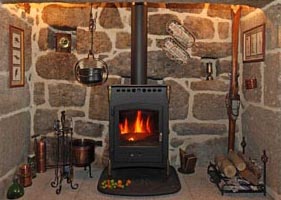
Shown below is a comparison of fireplace fuel efficiencies. However before you make a choice you also need to consider the price of each type of fuel and the efficiency of the fireplace itself.
- Wood - 4.4 kWh per kilogram
- Natural gas - 10.8 kWh per kilogram
- Liquefied Petroleum Gas (LPG) - 13.8 kWh per kilogram
- Ethanol - 8.3 kWh per kilogram
Wood fireplace efficiency
Standard open fireplace - up to 10% efficiency
Fireplace insert - 20 to 35% efficiency
Simple updraft stove or heater (not airtight) - 20 to 40% efficiency
Airtight stove or heater - 50 to 70% efficiency
A traditional open fireplace is very inefficient on fuel but they do look the part. Only a small amount of the heat it generates radiates out to the room. The remaining heat is lost in air passing out of the room, up into the chimney and then outside. Modifications and inserts can be made to make a wood fireplace more efficient, especially if it does not back onto an external wall. A well designed and located fireplace will enable more heat to be transmitted into your home, while ensuring that emissions are reduced.
Wood fireplace & heater choices
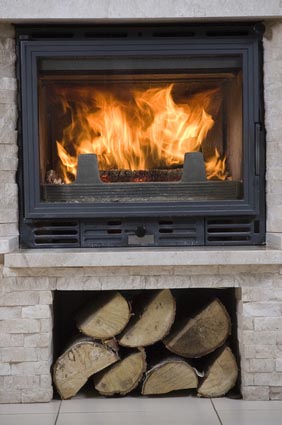 The most basic fireplace is a simple open hearth. This is what most people envisage when they think of wood heating, with all the ambience of dancing flames. However charming as they may be, they can waste money in construction and energy costs and pollute the air. Improvements in technology allow new technology fireplaces to do a better job of heating a home.
The most basic fireplace is a simple open hearth. This is what most people envisage when they think of wood heating, with all the ambience of dancing flames. However charming as they may be, they can waste money in construction and energy costs and pollute the air. Improvements in technology allow new technology fireplaces to do a better job of heating a home.
Fireplace inserts are hollow metal inserts built into an open fireplace. Rather than the heat going straight up the chimney air circulates around the insert and heats the room. Fireplaces can be further fitted with doors and air controls, as well as fans, to help move hot air into the room.
An updraft stove, such as a potbelly stove, is an enclosed fireplace. Air entry is at an uncontrolled rate, which is why they are less efficient than a slow combustion heater.
Slow combustion heaters are the most efficient. They combine an airtight firebox, air inlet controls, baffles and secondary air inlets and combustion chambers which maximises the conversion of the fuel into heat. Slow combustion heaters can reduce wood to almost nothing, leaving a smaller amount of ash to be cleaned out at the end.
More efficient units can be fitted into existing masonry fireplaces to improve your home heating.
The higher initial cost of a more efficient wood heater is repaid with more heat for each load of wood and less emissions.
Advantages of wood heaters or fireplaces
- Wood is a renewable resource
- You can grow your own free fuel supply if you have the space and time
- You can cut your own for free if you have access to trees
- Ash can be used for the garden, but with care. It is a good source of potassium and phosphorus and some micro-nutrients, but be aware that it raises soil pH. Too much ash is not good for a garden.
Disadvantages of wood heaters or fireplaces
- Wood is a bulky fuel, which impacts on its transport and storage
- Wood needs a dry place to be stored. It should not be stored against the house, as it is a fire hazard and a home for rodents and termites
- Wood is messy both before and after you burn it
- Your flue or chimney will need to be regularly cleaned (so that it works efficiently and does not’t become a fire hazard)
- Wood needs to be seasoned, which takes time. Burning unseasoned wood is not only less efficient, it will result in a build up of creosote in the flue or chimney, which can catch alight.
In Australia the guidelines are that wood heaters manufactured since 1992 must comply with AS/NZS 4013 to ensure smoke emissions are within a reasonable and safe limit. The installation of wood heaters is regulated by Australian Standard AS/NZS 2918. This states that you should have a minimum flue height of 4.6 metres, that it must be vertical, and the end of the flue cannot be near any windows or doors, so as to prevent expelled air from being pushed back into your home, among other things. If you need to view the Australian Standard ensure you are looking at the latest version, they are updated regularly.
Gas heaters
A gas fuelled heater burns natural gas or liquefied petroleum gas. They come in 'flued' and 'unflued' models. Remember: flue or not all gas heated rooms require some ventilation.
An unflued heater can be a permanent fixture or portable. A portable model has the advantage of not taking up space in the warmer months. However, unflued heaters can be risky if safety procedures aren’t followed.
Emissions from a gas heater are water vapour and carbon dioxide, but if there is incomplete combustion, carbon monoxide and nitrogen dioxide can also be emitted. Room ventilation is needed to ensure that health problems don't occur from these emissions - but this will cause some of your warm air to be lost.
A flued heater permits the escape of harmful gases to the outside. A correctly operating flued heater is usually safe.
One advantage of gas heaters over wood heaters is that wood fuelled heaters need to be flued vertically, whereas advances in technology allow gas heaters can be flued horizontally. This means that they can be installed in apartments and other locations that were not practical previously.
Gas fuelled fireplaces can be made to look like wood burning fires, with all the advantages of a clean fuel with the traditional crackling fire appearance.
Advantages of gas heaters
- cleaner than wood or coal
- readily available - if your are on main gas
- natural gas is a good option if available directly to the home
- Gas heaters produce approximately one third of greenhouse gas emissions of standard electric heaters.
- A gas log fire has the look of a wood fire without the disadvantages
- They have energy labels to help you choose the most efficient models.
- Gas heaters do not need chimneys
Disadvantages
- Possibility of leaks
- Malfunctioning units can emit carbon monoxide
- They do require some cleaning as dirt and dust can clog them
- Gaskets must be checked regularly
- Vented fireplaces need regular checks for debris
Ethanol heaters & fireplaces
Ethanol is a relatively new fuel for home heating. It is a natural fuel produced by industrial fermentation of sugar in sugar cane or starchy grains. The extracted alcohol is concentrated then dehydrated to form bio-ethanol. Bio does not mean organically grown, it means that it is derived from living plants. This means that it is a renewable energy.
Ethanol heaters come in a range of styles, from small table top models to full sized heaters, and outdoor ones. They can be off the shelf ones, or custom designed, but buy from a reputable company, for your own peace of mind.
Advantages
- Ethanol burning fireplaces don't require a flue or vent, as ethanol burns cleanly.
- Self installation is possible. The product will work straight from the box.
- Fuel is clean and easy to handle
- No smoke
- No ashes to clean up and dispose of.
- No chimney to clean
- Minimal maintenance
- Can be used to convert an existing wood or gas fireplace
- Can be stored away in warm weather
Disadvantages
- Uses oxygen in the room and produces carbon dioxide
- Produces water vapour
Both disadvantages can be minimised with adequate room ventilation, but they shouldn’t be used in a room without windows.
- Some odour is possible with refilling, first lighting and when extinguishing the flames
- A floor standing model is not a good idea around pets or children; consider a wall mounted one instead
- Fuel is a flammable substance and care needs to be taken, and a fire extinguisher kept on hand. The units should not be refueled when the fireplace is hot. Hands must be washed after refueling, and before the fireplace is lit.
In conclusion
In the end how you choose a fireplace will depend on your aesthetics, your budget, and the practicality of sourcing a sufficient amount of fuel.
